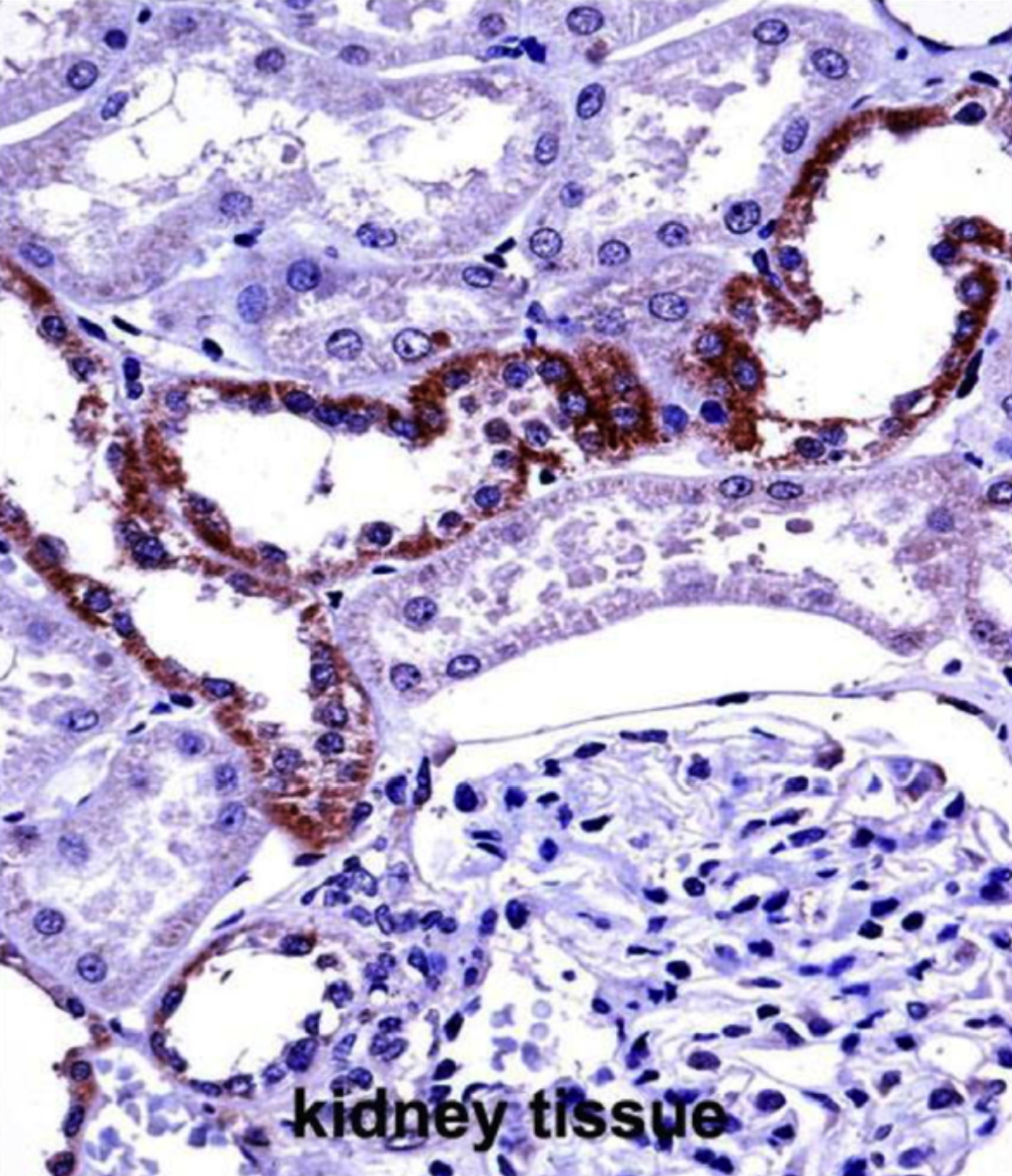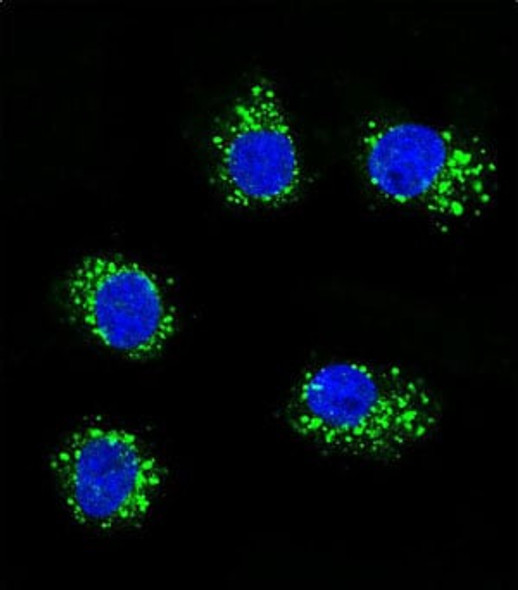Rabbit anti-Human MCOLN1 Polyclonal Antibody | MBS6007836 from Mybiosource
Product Name: MCOLN1, Polyclonal Antibody
Full Product Name: MCOLN1, CT (MCOLN1, ML4, Mucolipin-1, MG-2, Mucolipidin)
Product Synonym Names: Anti -MCOLN1, CT (MCOLN1, ML4, Mucolipin-1, MG-2, Mucolipidin)
Product Gene Name: anti-MCOLN1 antibody
Research Use Only: For Research Use Only. Not for use in diagnostic procedures.
MCOLN1, Polyclonal Antibody DataSheet
Chromosome Location: Chromosome: 19; NC_000019.9 (7587496..7598895). Location: 19p13.2
Species Reactivity: Human
Purity/Purification: Affinity Purified. Purified by Protein A affinity chromatography.
Form/Format: Supplied as a liquid in PBS, pH 7.2, 0.09% sodium azide.
Immunogen: MCOLN1 antibody is generated from rabbits immunized with a KLH conjugated synthetic peptide between 530-560 amino acids from the C-terminal region of human MCOLN1.
Preparation and Storage: May be stored at 4 degree C for short-term only. Aliquot to avoid repeated freezing and thawing. Store at -20 degree C. Aliquots are stable for 12 months. For maximum recovery of product, centrifuge the original vial after thawing and prior to removing the cap.
Other Notes: Small volumes of anti-MCOLN1 antibody vial(s) may occasionally become entrapped in the seal of the product vial during shipment and storage. If necessary, briefly centrifuge the vial on a tabletop centrifuge to dislodge any liquid in the container`s cap. Certain products may require to ship with dry ice and additional dry ice fee may apply.
Related Product Information: This gene encodes a memberof the transient receptor potential (TRP) cation channel gene family. The transmembrane protein localizes to intracellular vesicular membranes including lysosomes, and functions in the late endocytic pathway and in the regulation of lysosomal exocytosis. The channel is permeable to Ca(2+), Fe(2+), Na(+), K(+), and H(+), and is modulated by changes in Ca(2+) concentration. Mutations in this gene result in mucolipidosis type IV.
Product Categories/Family for: Antibodies; Abs to Proteins
Applications Tested/Suitable for: ELISA (EL/EIA), Western Blot (WB), Immunohistochemistry (IHC)
Application Notes for: Suitable for use in Western Blot, Immunohistochemistry, ELISA
Dilution: ELISA: 1:1,000
Western Blot: 1:100-500
Immunohistochemistry: 1:10-50
Western Blot (WB): Western Blot analysis of Jurkat cell line lysates (35ug/lane) using MBS6007836. This demonstrates that MBS6007836 detected the MCOLN1 protein (arrow).

Immunohistochemistry (IHC): Immunohistochemistry analysis in formalin fixed and paraffin embedded human kidney tissue using MBS6007836 followed by peroxidase conjugation of the secondary antibody and DAB staining. This data demonstrates the use of MBS6007836 for immunohistochemistry.

NCBI/Uniprot data below describe general gene information for MCOLN1. It may not necessarily be applicable to this product.
UniProt Primary Accession # Q9GZU1
UniProt Related Accession # Q9GZU1
Molecular Weight 65,022 Da
NCBI Official Full Name: mucolipin-1
NCBI Official Synonym Full Names: mucolipin 1
NCBI Official Symbol: MCOLN1
NCBI Official Synonym Symbols: ML4; MG-2; MLIV; MST080; TRPML1; MSTP080; TRP-ML1; TRPM-L1
NCBI Protein Information: mucolipin-1; mucolipidin; mucolipidosis type IV protein
UniProt Protein Name: Mucolipin-1
UniProt Synonym Protein Names: MG-2; Mucolipidin
Protein Family: Mucolipin
UniProt Gene Name: MCOLN1
UniProt Synonym Gene Names: ML4
UniProt Entry Name: MCLN1_HUMAN
NCBI Summary for MCOLN1:
This gene encodes a memberof the transient receptor potential (TRP) cation channel gene family. The transmembrane protein localizes to intracellular vesicular membranes including lysosomes, and functions in the late endocytic pathway and in the regulation of lysosomal exocytosis. The channel is permeable to Ca(2+), Fe(2+), Na(+), K(+), and H(+), and is modulated by changes in Ca(2+) concentration. Mutations in this gene result in mucolipidosis type IV. [provided by RefSeq, Oct 2009]
UniProt Comments for MCOLN1:
mucolipin 1: Cation channel probably playing a role in the endocytic pathway and in the control of membrane trafficking of proteins and lipids. Could play a major role in Ca(2+) transport regulating lysosomal exocytosis. Defects in MCOLN1 are the cause of mucolipidosis type IV (MLIV); also known as sialolipidosis. MLIV is an autosomal recessive lysosomal storage disorder characterized by severe psychomotor retardation and ophthalmologic abnormalities, including corneal opacity, retinal degeneration and strabismus. Storage bodies of lipids and water-soluble substances are seen by electron microscopy in almost every cell type of the patients. Most patients are unable to speak or walk independently and reach a maximal developmental level of 1-2 years. All patients have constitutive achlorhydia associated with a secondary elevation of serum gastrin levels. MLIV may be due to a defect in sorting and/or transport along the late endocytic pathway. MLIV is found at relatively high frequency among Ashkenazi Jews. Belongs to the transient receptor (TC 1.A.4) family. Polycystin subfamily. MCOLN1 sub-subfamily.
Protein type: Channel, cation; Membrane protein, multi-pass; Membrane protein, integral; Transporter, ion channel
Chromosomal Location of Human Ortholog: 19p13.2
Cellular Component: late endosome membrane; lysosomal membrane; integral to plasma membrane; cytoplasm; plasma membrane; integral to membrane; endosome membrane; receptor complex
Molecular Function: cation channel activity
Biological Process: cellular iron ion homeostasis; release of sequestered calcium ion into cytosol; transferrin transport; transmembrane transport; cation transport
Disease: Mucolipidosis Iv
Precautions
This product is for scientific laboratory research purposes and are not for diagnostic, therapeutics, prophylactic or in vivo use. Through your purchase, you expressly represent and warrant to MyBioSource that you will properly test and use any Products purchased from MyBioSource in accordance with industry standards. MyBioSource and its authorized distributors reserve the right to refuse to process any order where we reasonably believe that the intended use will fall outside of our acceptable guidelines.
Disclaimer:
While every efforts were made to ensure the accuracy of the information provided in this datasheet, MyBioSource will not be liable for any omissions or errors contained herein. MyBioSource reserves the right to make changes to this datasheet at any time without prior notice.












